Indoor Plant Styling Tips
For anyone looking to elevate their next photo shoot or home staging project, here are some indoor plant styling tips featuring easy-care greenery that photographs beautifully and thrives indoors. Inspired by my recent LA ‘design showroom‘ trip and a photo shoot at one of our new construction projects on Boston’s South Shore.
Before styling any space for a shoot, I start with greenery. Fresh-cut flowers are lovely but are often a last-minute call and are fully dependant on what’s available at the flower market. Seasonal timing matters too—one year, while shooting near Valentine’s Day, tulips were the only decent option… not the sexiest decor. And since the flower market can be unpredictable in general, I always begin with the dependable houseplant.
Of course, we still layer in blankets and decorative objects for the final pics, but plants anchor the styling and influence nearly every other decision. They bring life to a room and photograph beautifully—a key reason I rely on these go-to indoor plant styling tips in nearly every shoot. If you’re planning a shoot, redecorating a space, or staging a home, these greens can add life, texture, and shape to any interior. Read on for some plants I admired on a recent trip to LA, along with photos from a shoot I styled back East.
Showroom Greenery from LA
Los Angeles still leads when it comes to houseplants. Maybe it’s fresh on my mind after Legends Design Week, but the point stands. The restaurants, shops, and showrooms I visited all featured AMAZING greenery, many with species simply not feasible in cold New England weather. Jenna Cooper’s showroom deserves a post of its own—the plants are lush, intentional, and clearly cared for by professionals. Her staff confirmed a local company handles plant maintenance, and it shows. The space feels styled but alive, and the plants play a big role in that balance.
A pair of Song of India plants stood out with their striped leaves and sculptural shape. They like bright, indirect light and infrequent watering, but benefit from steady humidity. A tall Burmese fishtail palm caught my eye—full at the top, neatly pruned at the base. It prefers filtered light, regular watering, and high humidity. A classic oleander in a fluted pot added structure. This one needs full sun, good drainage, and occasional deep watering. A dragon tree nearby felt like sculpture, with minimal leaves and moss at the base. It’s low-maintenance, tolerating low light and infrequent watering. Lastly, a blue star fern on the counter added softness. It thrives in medium light and tolerates missed waterings better than most ferns.
Obviously, you can Google your own plant maintenance tips—I actually use an app called PictureThis to track, diagnose, and plan watering, light, and fertilizing for all my plants. But the visuals here are amazing inspiration. Take note of the pots and the carefully placed moss covering each root. The pruning stands out, too.
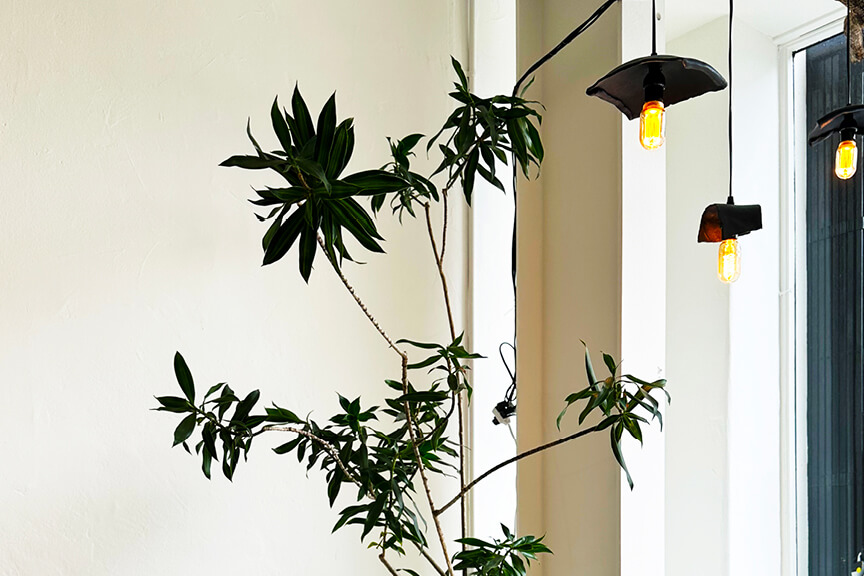
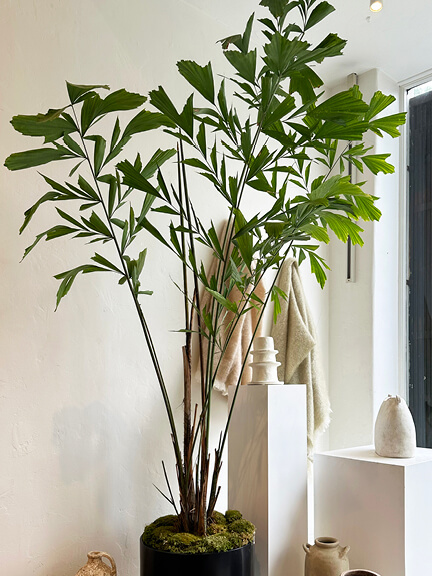
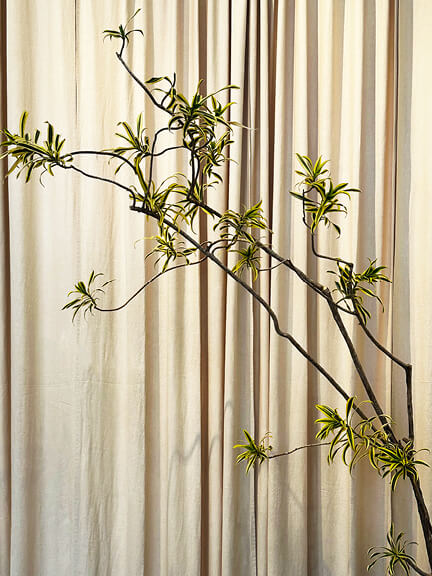
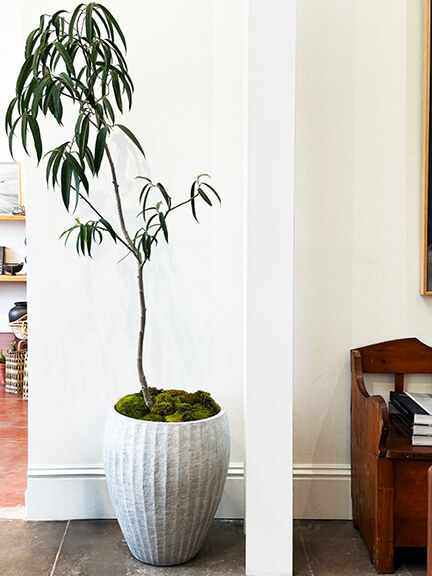
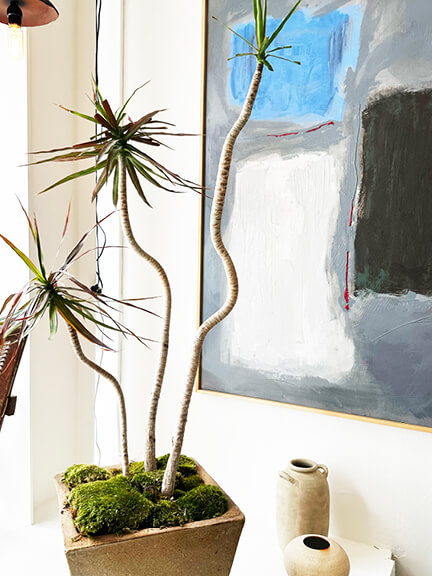
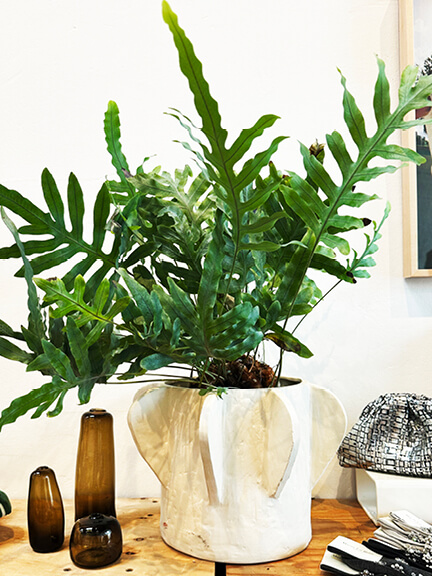
Low-Maintenance, High-Impact Greens
At my own photoshoot back East, I borught a load of houseplants to the shoot. Let’s start with the easy-care crowd—plants that typically need water once a week. Myrtle topiaries are a longtime favorite, though they’re a bit tricky to care for. They prefer consistently moist soil and don’t tolerate neglect. If you’re willing to keep up, they’re worth it. Polka dot begonias are bold and graphic, and yes—polka dots are back this season. Heart of Jesus (Caladium) adds color and drama with sculptural nad colorful leaves.
A collection of pots can be just as varied as the plants themselves—black terracotta, a concrete-like one with soft curves, a white-and-sage version purposefully weathered, and a pristine modern white vase with a low profile. Keep plants in their nursery pots and place a plastic dish inside the decorative vessel to prevent water from pooling. Of course, as the plants grow, you’ll need to repot into larger containers—we keep a collection on hand and rotate as needed.
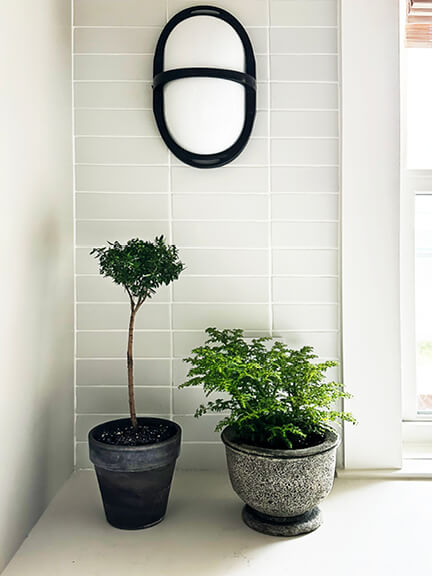
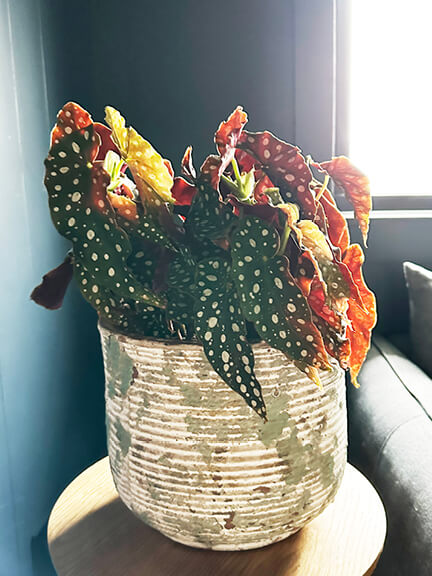
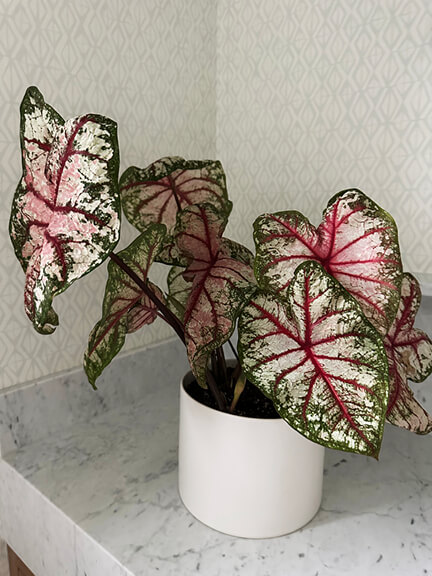
Mid-Maintenance Plants
Next are the plants that need water about every 10 days. Japanese aralia—also called Japanese fatsia—does well indoors with cool, indirect light, especially from north- or east-facing windows. Dwarf umbrella trees (Schefflera arboricola) are another easy-care option: sculptural, full, and perfect for softening corners. They prefer bright, indirect light and typically need water every 10 to 14 days, making them ideal for frequent travelers—or the occasionally forgetful. Lastly, a bonsai tree—a classic nod to Asian influence. This one was a Goldegate ficus, styled with precision and balance. It thrives in bright, indirect light with steady moisture but doesn’t like soggy soil. Prune regularly to maintain shape and encourage dense growth.
The planters also bring their own sense of style. The first is a true urn, adding height to a smaller plant—always a smart move. I found this one at Kennedy’s Country Gardens in Scituate; it’s suitable for both indoor and outdoor use. The large umbrella tree sits in an oversized white floor vase, which I rotate with different plants. It also works well with taller trees like a ficus (fig). The bonsai, of course, calls for a smaller vessel—here, a low rectangular dark green ceramic pot. Vary the colors, shapes, heights, and finishes, just as you would with the plants themselves.
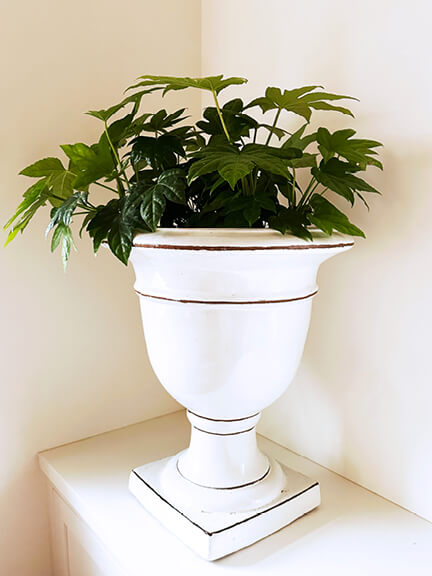
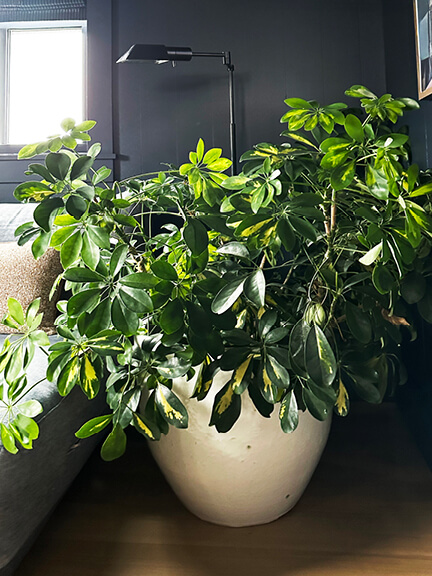
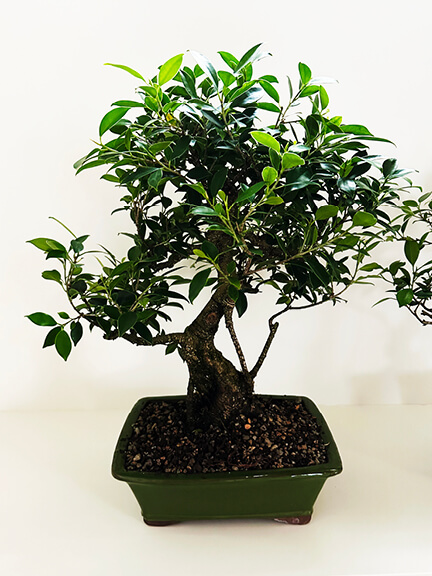
The Drought-Tolerant Crowd
Then come the long-haul plants—those that only need watering every two to two and a half weeks. These are mostly succulents: blue chalk sticks, string of pearls, pink ice plant, and needle stonecrop. All four thrive in bright sun and dry, well-draining soil. Water them thoroughly, then let the soil dry out completely before watering again.
Blue chalk sticks have a sculptural, icy-blue tone that works beautifully in spaces with room to grow—giving wig-like vibes with their flowing locks. You can’t see it here, but they’re planted in a charming yellow vase. String of pearls adds a soft, trailing element that looks great draped over open shelving. Pink ice plant brings a splash of color and may even bloom in the right conditions. I grouped these three together in a concrete-like rectangular vase since they all require the same sun, water, and care.
Needle stonecrop is hardy and low-growing—it even bloomed tiny yellow flowers on my windowsill after a long winter. A little goes a long way. I keep mine in a low pot that fits neatly inside a ceramic fruit bowl from Williams Sonoma. The insert keeps the messy part contained, while the greenery sits in a more delicate and feminine vessel.
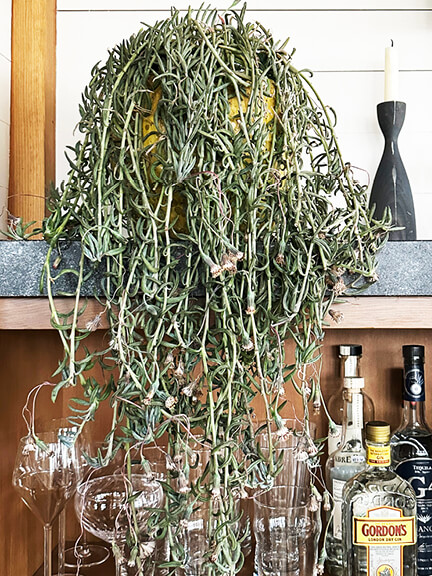
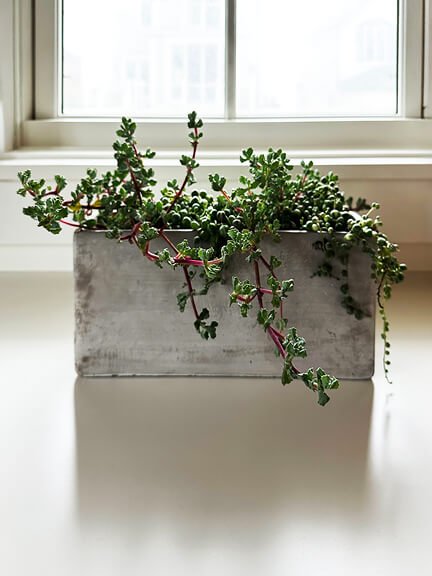
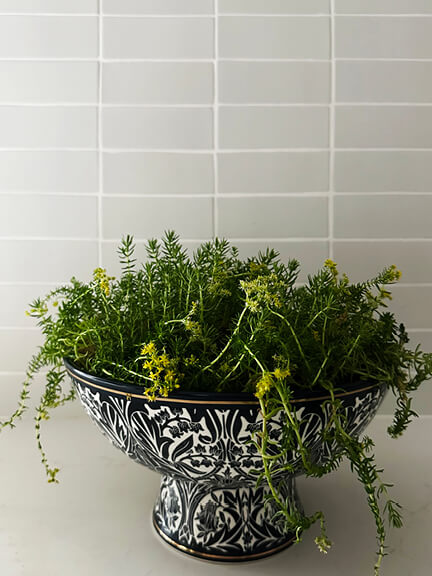
Effortless to Style, Even Easier to Keep Alive
If you’re over the fiddle leaf fig (no shade, I still have two at my own place) and done with eel grass (too corporate), this list should spark ideas. These houseplants are easy to style, easy to live with, and easy to love. They bring shape, softness, and life into a space—essential for any photo shoot, but even more essential in real life. A room isn’t finished until something green is growing in it. For more ideas on how I approach layering, styling, and finishing a space, head to my post on decorating and styling.
LA Plant Styling Cheat Sheet
- Song of India (Dracaena reflexa) – every 7–10 days; bright, indirect light; prefers humidity; allow top inch of soil to dry
- Burmese Fishtail Palm (Caryota mitis) – every 7–10 days; filtered light; keep soil evenly moist; avoid drafts
- Oleander (Nerium oleander) – every 7–10 days; full sun; allow soil to dry slightly between waterings; prune after flowering
- Dragon Tree (Dracaena marginata) – every 10–14 days; low to bright indirect light; water when soil is half dry; tolerates neglect
- Blue Star Fern (Phlebodium aureum) – every 7–10 days; medium, indirect light; water when soil is slightly dry; tolerates some missed waterings
Weekly Watering Wonders
- Myrtle Topiary – 2–3x/week; bright indirect light; keep soil consistently moist
- Polka Dot Begonia – 1x/week; bright indirect light; let top inch dry
- Heart of Jesus (Caladium) – 1x/week; bright indirect light; prefers humidity
- Artillery Plant – keep soil moist; bright indirect light; fast grower
- Needle Spikerush Grass – keep soil wet; full sun or bright light; best short-term indoors
Moderate Care Plants
- Japanese Aralia (Fatsia) – every 7–10 days; indirect light; avoid direct sun
- Creeping Charlie – every 7–10 days; bright indirect light; trails nicely in shallow pots
- Alocasia Zebrina – every 7–10 days; bright indirect light; needs warmth and humidity
- Dwarf Umbrella – every 7–10 days;
Succulents That Can Handle Neglect
- Blue Chalk Sticks – every 2–3 weeks; full sun; needs drainage
- String of Pearls – every 2–3 weeks; bright to direct sun; well-draining soil
- Pink Ice Plant – every 2–3 weeks; full sun; drought-tolerant, may bloom
- Needle Stonecrop – every 2–3 weeks; full sun; hardy, may bloom in spring
- Burro’s Tail – every 2–3 weeks; bright indirect light; handle with care
- Ponytail Palm – every 2–3 weeks; bright to full sun; water when fully dry